In this year like no other, rental markets across Canada experienced significant changes. COVID-19 pushed property managers and landlords to pivot, innovate and, above all, integrate digital tools into their marketing and operational practices. This ability to adapt showcases the ingenuity of the industry and ensures it is well-positioned to meet other headwinds that may come it’s way in the future – albeit unlikely to compare to what we all experienced in 2020.
Want to access the full report?
The latest report about the Toronto Rental Market. Review key trends from 2020.
Get insights and predictions to prepare yourself for 2021.
Video Transcript
This article is a partial transcription from our live liv.talk webinar 2020 Toronto Rental Market Recap + 2021 Predictions. Download the full report now and watch the video to learn about how the Toronto rental market was affected by the pandemic and where it’s headed in 2021.
Through it all, liv.rent has been collecting and analyzing rental market data to now be able to provide a comprehensive recap of our findings and present our predictions for 2021.
Table of Contents
Top 5 Toronto Rental Market 2020 Insights
Below we discuss what we’ve learned through our monthly data analysis of the Toronto rental market.
If you’d like to stay up-to-date on the market, be sure to subscribe to our newsletter for monthly reports on the Toronto rental market.
1. Toronto saw the biggest % drop in rental prices compared to other Canadian cities
Compared to the other major Canadian cities, Toronto experienced the biggest percentage drop in rental prices in 2020. For a 1 bedroom unfurnished rental, prices dropped by 3.3% in Toronto, 1.4% in Vancouver and 1% in Montreal. In contrast, the nation’s capital, Ottawa, saw an opposite trend with a 1.2% increase in average rent.
Toronto experienced an even bigger drop in rates for furnished rentals – a 13.1% decrease compared to a 4.6% drop in Montreal, 2.4% in Vancouver and, once again, a 14.8% increase in Ottawa’s furnished rental market.
>> For additional insights into the Toronto Rental Market, check out liv.rent’s 2020 Toronto Rental Market Webinar
This steady decline in rental prices began in March, which was when COVID-19 hit. There was a slight but fleeting increase in furnished rental rates during the summer months of July and August likely due to summer travel or study. However, the downward pressure on unfurnished rentals persisted throughout the summer into fall and winter, with December seeing the biggest decline.
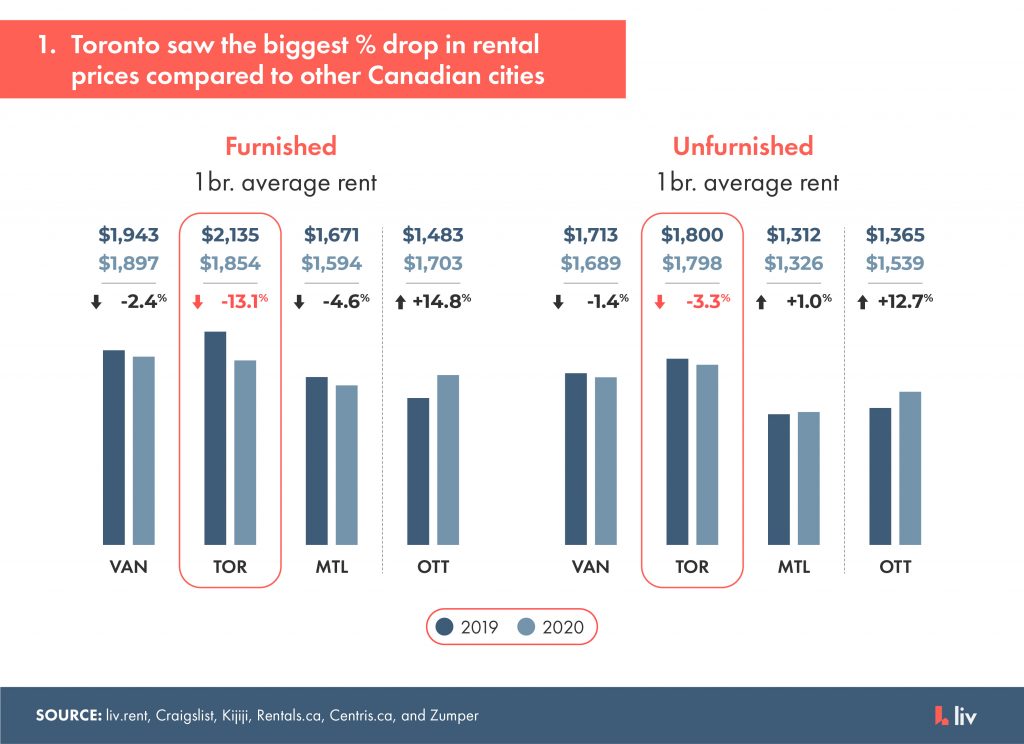
liv.rent – Search apartments & houses for rent in Toronto
Search houses, rooms, condos and apartments for rent in Toronto. Chat instantly with verified landlords. Apply to multiple listings. Save your chat history & signed documents all in one platform.
2. Rental decreases were not limited to the downtown core
Downward pressure on rental rates was not isolated to downtown Toronto. The entire Greater Toronto Area witnessed drops as compared to 2019 rates. Taken together, the dip was more significant. An 8.6% drop in rental rates for a 1 bedroom unfurnished rental and 15.8% for furnished. Overall, the average monthly rent for a 1 bedroom across the region was $1,826, down over $100 from the 2019 average of $1,997.
For furnished apartments, the biggest drops were seen in Brampton (-33%), Scarborough (-30%), Markham (-27%) and Downtown Toronto (-23%)
For unfurnished apartments, the biggest drops also occurred in Brampton (-20%), Markham (-19%), Scarborough (-18%) as well as Vaughan/Richmond Hill (-16%).
Despite this downward trend, Downtown Toronto continues to have the highest average monthly rent at $2904 for a furnished, one-bedroom and $2714 for an unfurnished unit in the GTA.
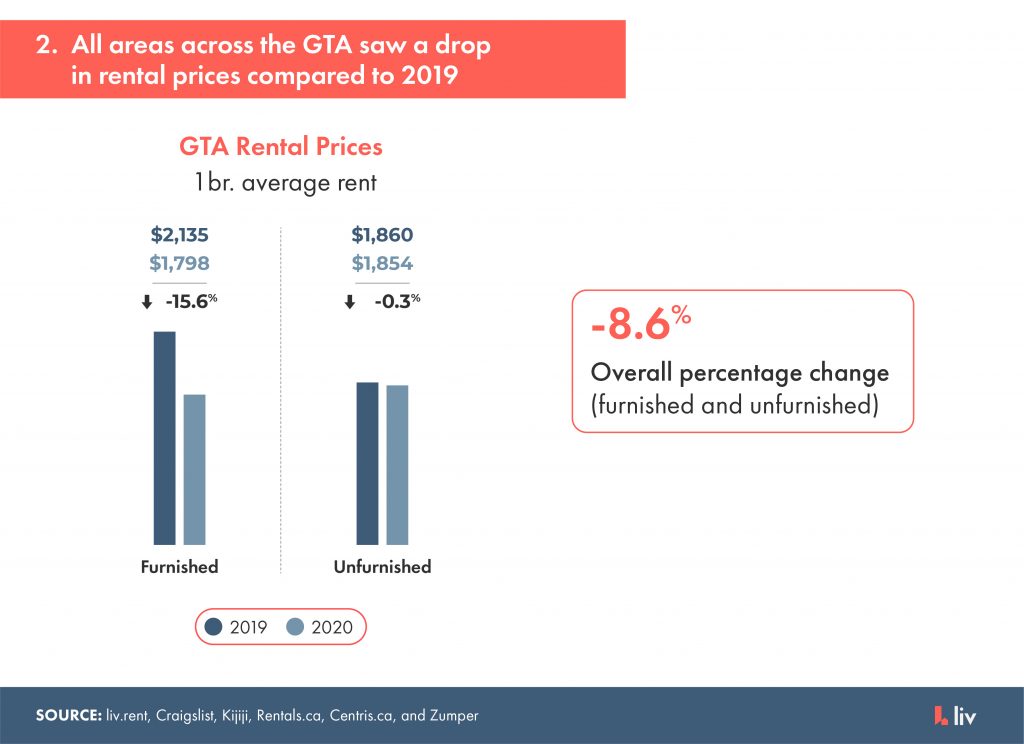
Want to access the full report?
The latest report about the Toronto Rental Market. Review key trends from 2020.
Get insights and predictions to prepare yourself for 2021.
3. Downtown Toronto sees a steady decline
Like the numbers for the entire GTA, the rental rates for the downtown core have seen a significant and steady decline since the beginning of the pandemic in March.
In our 2020 Toronto Rental Market Recap webinar, Elena Sardidis, Real Estate Sales Rep, Brad J. Lamb Realty, explains this downward pressure:
“COVID-19 sparked a return to home for business travellers and students, all able to work from home now and many buildings imposed an outright ban on Airbnb short term rentals. Their owners flipped these properties onto the long term rental market; thus increasing supply. Also, a bunch of developers saw their projects completed just as the pandemic hit – unfortunate timing that saw even more units being added to the rental market.”

4. GTA suburbs were most impacted
Overall, Scarborough, Brampton and Markham saw the largest percentage drops in rental prices taking into account both furnished and unfurnished properties.
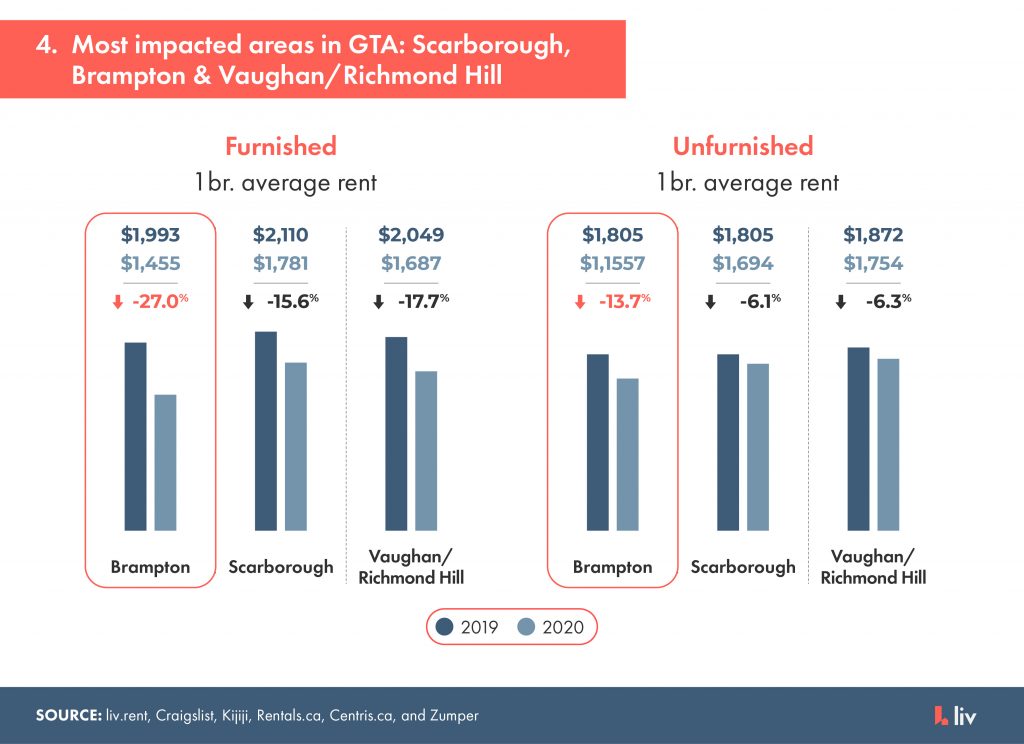
Elena Saradidis, Brad J. Lamb Realty: “Before, many moved based on price. It was a little bit cheaper to get into these areas; they could save on rent, parking was available and they didn’t mind the commute. What happens then when the downtown core sees price drops which are now the same prices as the suburbs? Why wouldn’t they want to move closer to the core in anticipation that when things open up again, ‘I have a place in downtown Toronto, covered under rent control and closer to work’. Also, many people in Brampton, Vaughan and Richmond Hill have converted into buyers in this market.
>> Recommended Reading: December 2020 Toronto Rent Report
5. Mississauga and Vaughan/Richmond experienced rent rebounds in December
Two suburbs saw slight rent rebounds towards the end of 2020 – Mississauga and Vaughan/Richmond Hill while downtown Toronto continues to experience downward pressure on rental rates.
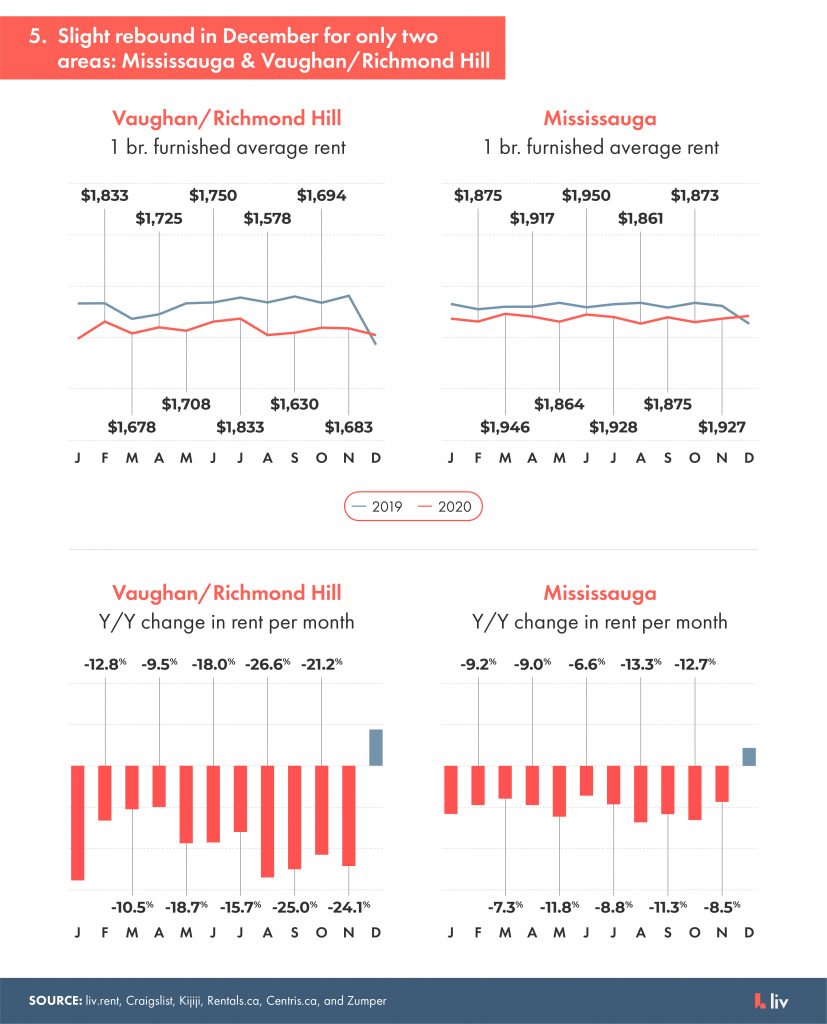
6. Multi-bedroom apartments in Toronto saw largest drop in rental prices
Larger rental properties with 3 or more bedrooms experienced the biggest drop in rental prices in the GTA. Furnished 3 bedroom rentals saw the most dramatic decrease. Rental prices in Scarborough dropped by 40%, Brampton 38%, Markham 34% and Downtown 31%. Regardless of unit size, Brampton’s rental market was hit the hardest in 2020.
This data point is interesting; with people looking for larger rentals, the assumption is that multi-bedroom apartments would sustain their 2019 rates. However, a number of pandemic influences impacted the reduced demand for these bigger units.
Firstly, roommate arrangements became less desirable as the pandemic forced all roommates home at the same time. Secondly, many students in such arrangements returned home. In both cases, leases were abandoned on many multi-bedroom rental properties and some of these tenants then opted to rent a smaller studio and one-bedroom units which became more affordable. In addition, many families planning to come to Canada put immigration plans on hold, further reducing demand for this type of rental property.
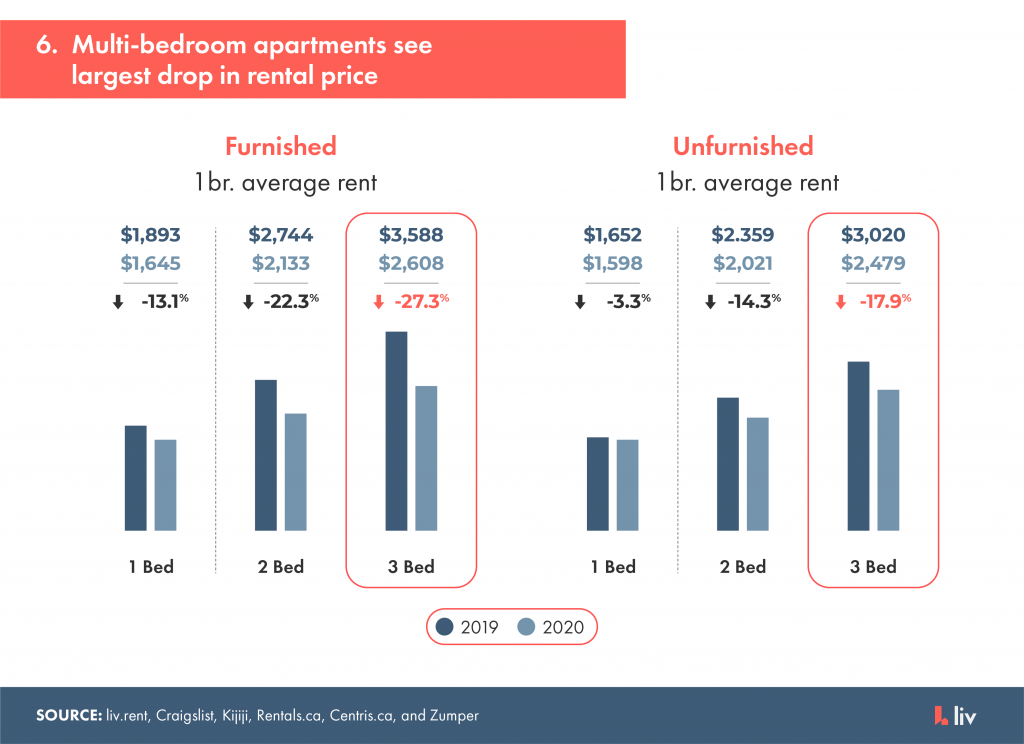
Want to access the full report?
The latest report about the Toronto Rental Market. Review key trends from 2020.
Get insights and predictions to prepare yourself for 2021.
Top 8 Rental Market Trends & 2021 Forecasts
In Canada’s biggest city, Toronto, the size of the rental market has enabled us to tease out some key trends spurred on by 2020’s pandemic and allow us to make some informed predictions for 2021:
1. Renters continue to live away from city centres in 2021
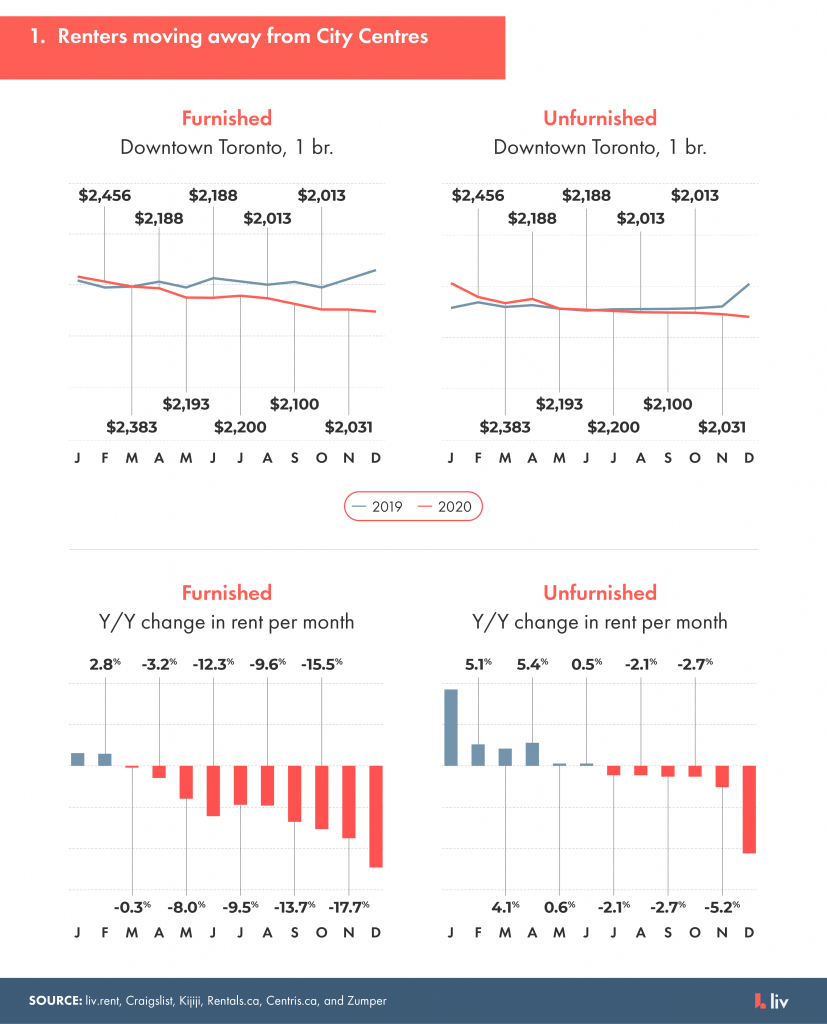
As people sought extra elbow room, they were quick to realize it was more cost-effective to move further away from the city centre where the cost per square footage was lower. With the commute no longer an issue, many realized their dream of renting a bigger home was within reach if they moved to the suburbs.
2021 Forecast – Once offices invite employees back to the office, universities resume in-person classes and travel restrictions are lifted, we see this trend slowing. The vibrancy of the downtown core will attract renters to return.
Moreover, greater condo availability and lower rent prices will likely entice some people, once again, to live closer to their workplaces, avoiding a commute. Many workplaces are going to great lengths to redesign their office spaces in a COVID-friendly way, eliminating lounges and other congregating areas, in order to assure safety and to encourage workers to slowly return.
Elena Saradidis, Brad J. Lamb Realty, “It will depend on how fast they can circulate vaccines. So do I think people will continue to live away from city centre? Temporarily, yes. Long term, no. I see people coming back. People like having things to do. But the rental market will take time to recover to pre-pandemic levels especially with the influx of inventory.”
>> Recommended Reading: Tenant Responsibilities when Moving out in Toronto
2. More short term rentals being converted to long term rentals
Given global travel restrictions, quarantine requirements and the severe slowdown in business travel, landlords and property managers of short term rentals experienced a dramatic downturn in demand. In response, many were forced to place their properties on the long term rental market, adding to the supply.
2021 Forecast – As long as travel restrictions and quarantine requirements are still in place, this trend will persist for the foreseeable future. Once a vaccine is widely distributed and travel restrictions are lifted, short term rental options will be re-introduced gradually – though, some downtown buildings have now banned them. However, landlords that have managed to secure long-term tenants will be compelled to honour those rental arrangements.
Moreover, given that short term rentals are typically furnished, it follows that furnished rentals will continue to experience less demand.
As Elena Saradidis, Brad J. Lamb Realty explains…as a landlord, “You’ve got to be flexible. If you have a furnished rental, it has to be very nicely furnished in order for you to potentially earn more in rent. However, right now, most people don’t want furnished places so you should provide the option to rent it unfurnished.”
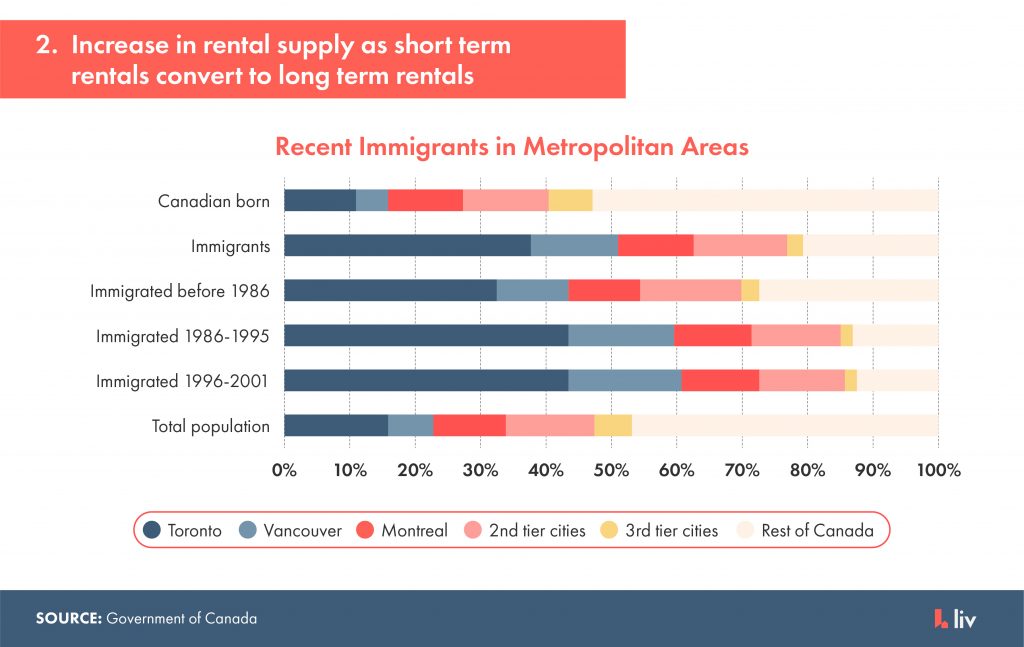
liv.rent – Search apartments & houses for rent in Toronto
Search houses, rooms, condos and apartments for rent in Toronto. Chat instantly with verified landlords. Apply to multiple listings. Save your chat history & signed documents all in one platform.
3. See a boost in incentives for renters
Due to the increase in available rentals, Toronto property managers and landlords have resorted to offering some remarkable incentives to attract and retain renters. In addition to steadily declining average monthly rents, some are offering a few months of free rent, free internet, steep discounts on longer-term leases or even cash bonuses.
2021 Forecast – As per our prediction, that downward pressure on rental rates will persist throughout 2021. So long as rental supply outweighs demand, the active courting of renters will continue. Incentives may become more generous and creative and will be designed to secure longer-term leases.
In addition, more tenants will seek the help of realtors to help find their next rental. Many landlords will list their rentals on MLS and pay real estate agents a commission for finding tenants.
For landlords, Elena Saradidis reiterates, “A good tenant goes a long way. If you have someone that is good, and they are offering less rent, take it. Ask yourself, ‘How much would you pay to get rid of a bad tenant vs. how much to have a great tenant?’ When you have a good tenant, you should be more willing to negotiate on price because, long term, it will cost you less in tenant turnover.”
4. Broad adoption of technology to streamline the rental process
A significant development, directly related to the pandemic but with staying power, is the broad adoption of digital tools by the rental community – landlords and renters alike. Platforms like liv.rent have gained significant traction. Through a contact-free process, renters can search, view and sign contracts digitally to secure their rental. Rent payments are also done online. Likewise, landlords have started relying on platforms like liv.rent to screen renters, facilitate video tours of rental properties, as well as manage applications and contracts online.
2021 Forecast – Digital transformation of the rental process will accelerate in 2021. For the rental real estate market, the ability to offer video tours, digital contracts and payment functionality, is no longer a luxury but a necessity.

5. Toronto will remain a renters’ market in 2021
This year has been described as a ‘once in a lifetime’ rental market in Toronto. This is due in large part to the reduction in new immigrants and from the drop in domestic and international student demand. Given the remote learning circumstances dictated by Canadian colleges and universities, many students opted to stay home. This has left many properties without tenants, dramatically increasing the rental supply, and placing downward pressure on rental rates.
For landlords, Elena Saradidis recommends “If you have a bunch of rentals now, it is not the time to hold out for the highest price. Drop it to a reasonable price that’s going to get you a tenant now.”
2021 Forecast – Toronto will remain a renters’ market well into 2021 as rental vacancy rates continue to climb upwards. This is especially true for studios and 1-bedroom condos which account for 61% of new units. Developers have been slow to respond to demands for larger units, citing construction and development costs. As a result, condos in the city of Toronto have been the only property type to lose value in a booming COVID real estate market. (Source: Globe and Mail).
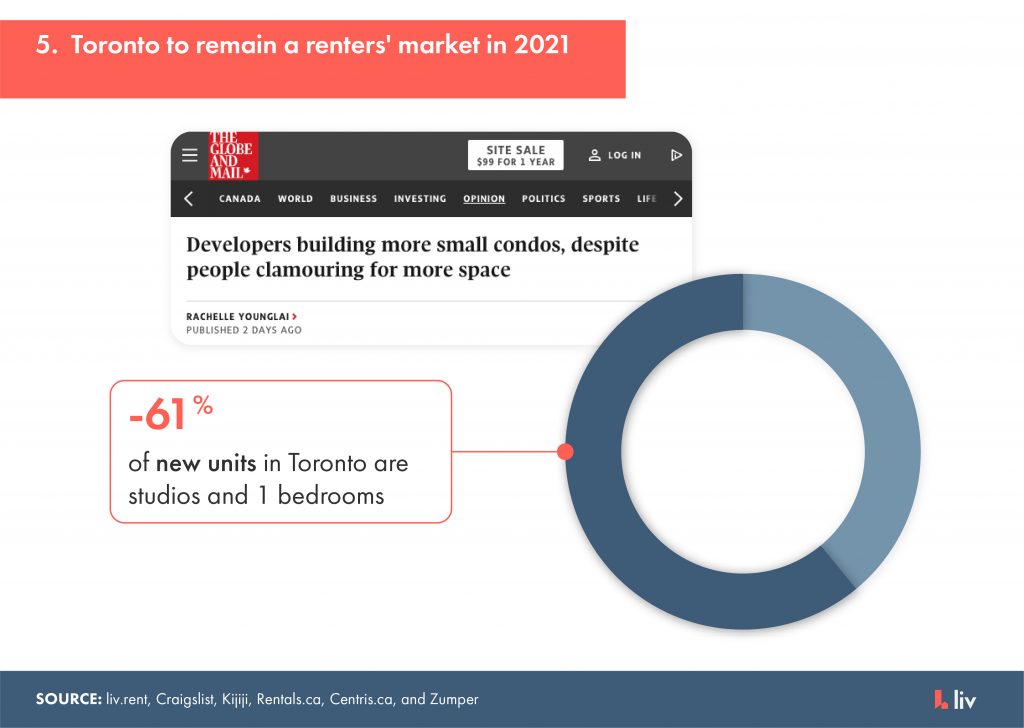
6. Renters continue to seek bigger spaces
As many were driven away from their offices to work at home in 2020, previously adequate spaces, began to feel small especially for those in shared living arrangements with family or roommates. It was one thing when we were cohabiting with busy people on different schedules, but quite another when everyone was home, ALL THE TIME. As a result, many renters (and buyers) moved to more spacious properties.
Elena Saradidis, Brad J. Lamb Realty:
“Two bedrooms listings are getting more action than anything smaller. The mentality is, ‘If I am working from home for the foreseeable future, why wouldn’t I work from a home that can accommodate it’. Couples are moving to one bedroom and den or two bedrooms and designating a space as their office. For landlords, you’re getting more security because instead of relying on one person’s income, you are relying on two.“
2021 Forecast – Until workplaces welcome employees back to the office and universities resume in-person classes, this trend will not abate. People will want a designated home office and in general more space to accommodate school, career and leisure pursuits at home. Nonetheless, demand for rentals in downtown Toronto will pick up again once a vaccine has been distributed.
Want to access the full report?
The latest report about the Toronto Rental Market. Review key trends from 2020.
Get insights and predictions to prepare yourself for 2021.
7. Shift in renters’ preferences
In addition to the demand for more space, we will see a shift in renters’ preferences. As we grow accustomed to the repeated calls of public health officials for social distancing, shared common spaces like elevators, lobbies, and laundry rooms become less appealing. In Toronto, this has meant diminished demand for units in condo buildings; thus, resulting in serious price drops for this inventory type, paired with increasing prices for rentals in low rise products like single houses, townhomes or three/four-storey walk-up buildings.
2021 Forecast – In all likelihood, these COVID-induced preferences will not impact developers’ plans in the short term (2021) but if they persist, then a broader rethink on how we live will impact how developers design and build.
8. Stronger incentive to buy instead of rent
Thanks to historically low mortgage rates, many renters are emboldened by their new buying power and incentivized to buy versus rent; thereby, further reducing demand for rentals. Additionally, some landlords are choosing to sell their rental properties as the short-term rental market has all but disappeared and filling them with long-term tenants has become increasingly difficult due to the influx of inventory.
2021 Forecast – Low mortgage rates are expected to continue throughout 2021 suggesting continued interest in home-buying. Nonetheless, as many federal and provincial COVID support payments come to an end, buyer insecurity may lead to dampened home-buying interest, which, in turn, would boost interest in renting.
To close, we cite Elena Saradidis, one more time:
“The moment the vaccine starts to circulate, the moment businesses start to reopen, the moment immigration picks up again, the city will recover.”
Want to access the full report?
The latest report about the Toronto Rental Market. Review key trends from 2020.
Get insights and predictions to prepare yourself for 2021.

Rethink The Way You Rent
Not on liv.rent yet? Experience the ease of digital applications & contracts, verified tenants & landlords, virtual tours and more – all on one platform. Sign up for free or download the app.
Subscribe to receive monthly updates on Canada’s major rental markets. Discover last month’s Rent Reports below:
Vancouver Rent Report
Ontario Rent Report
Montreal Rent Report
Calgary and Edmonton Rent Report

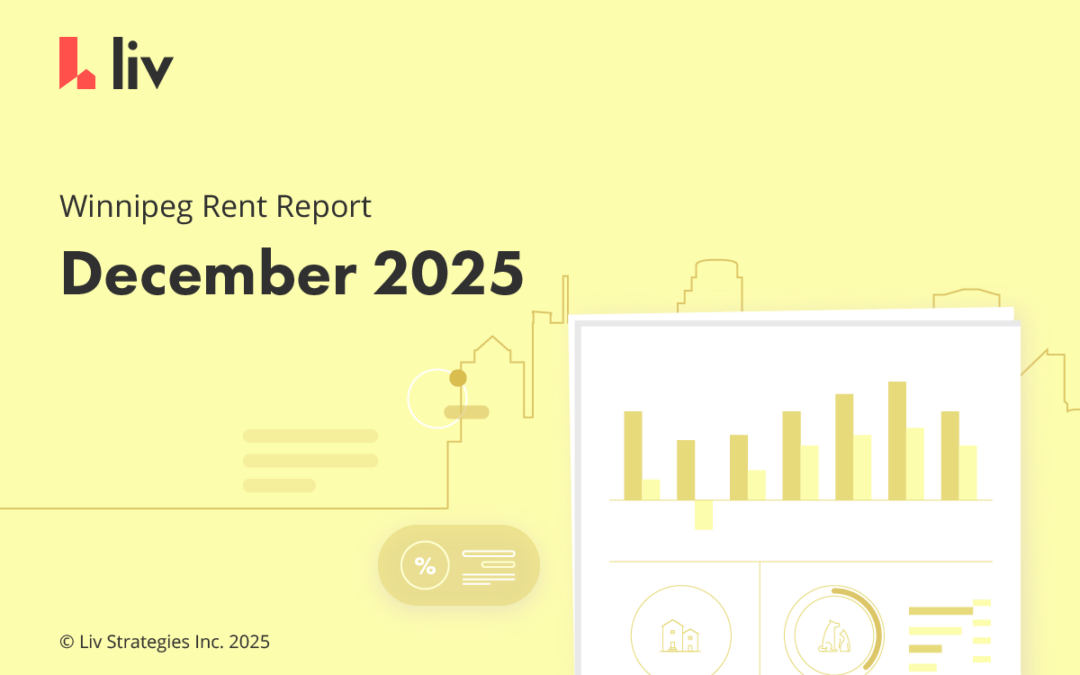
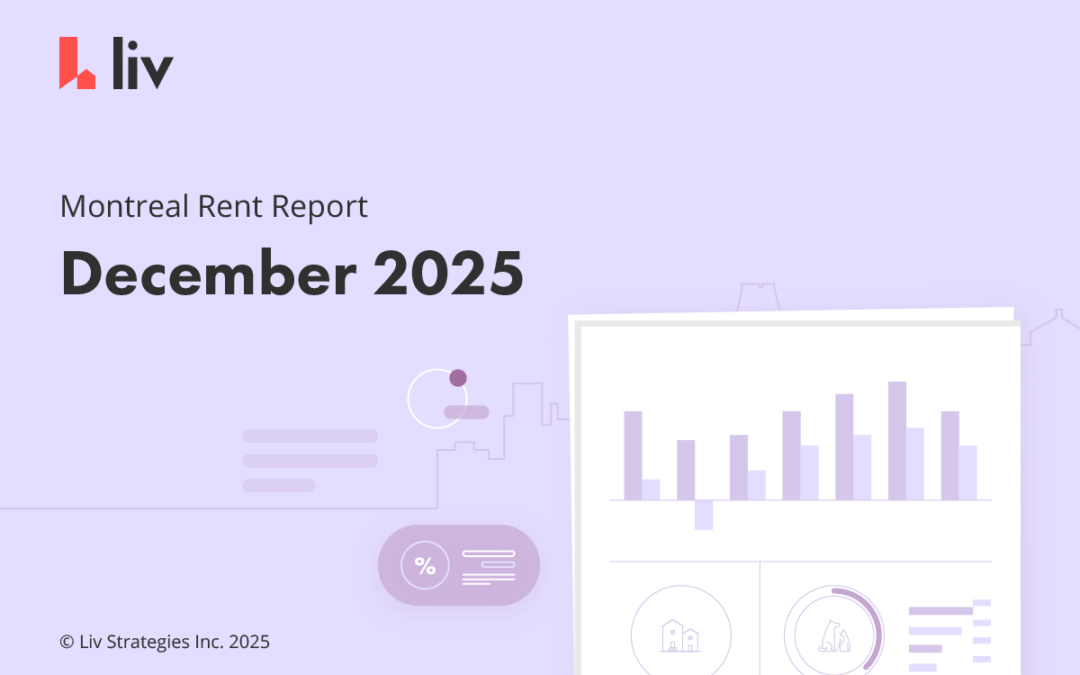
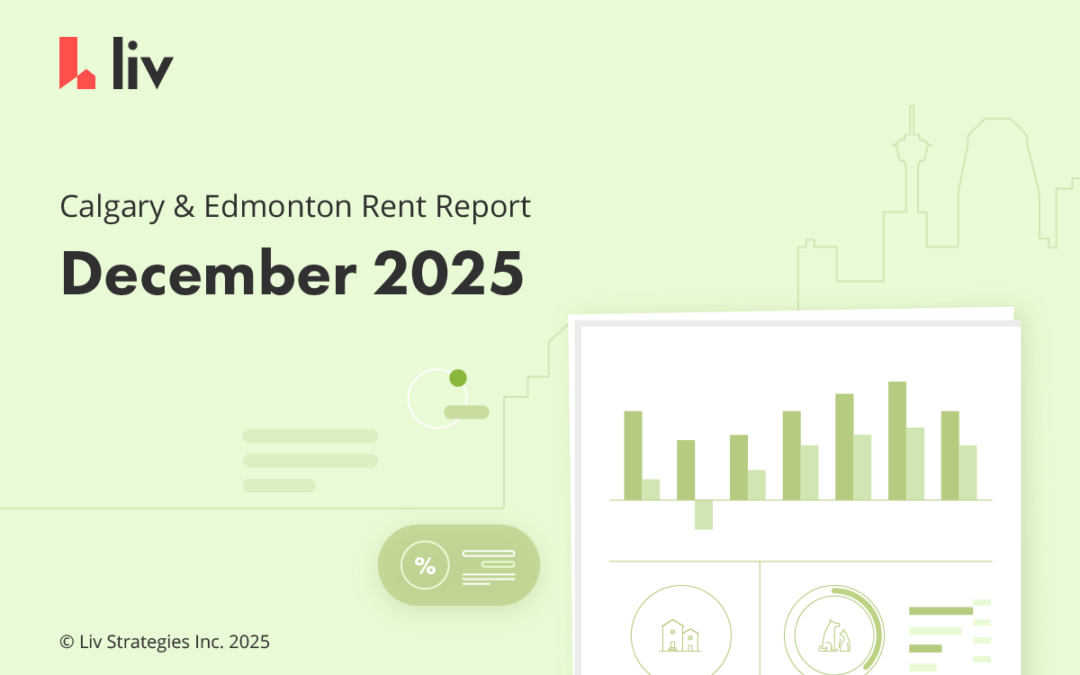
0 Comments